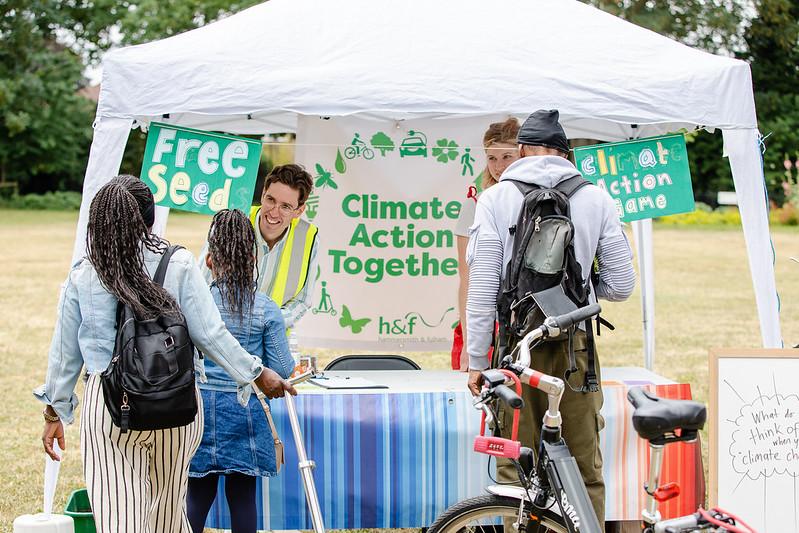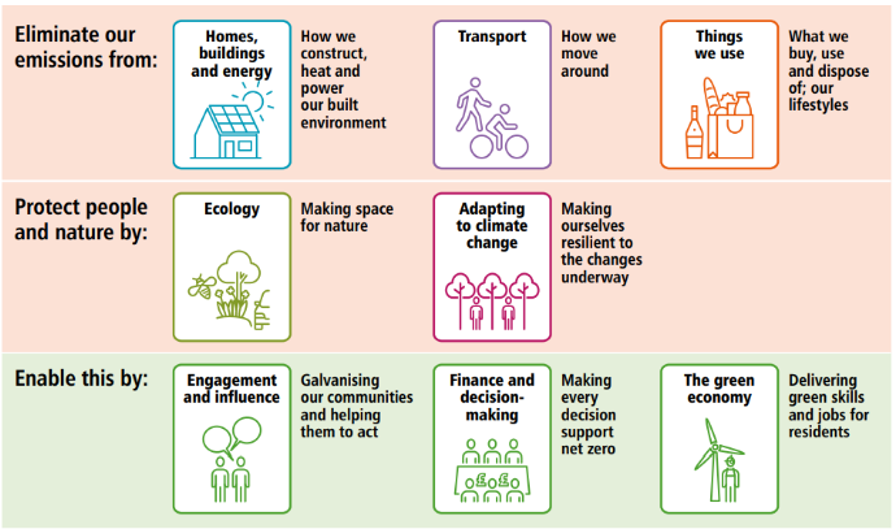Policy CR1
Climate emergency
The council will prioritise measures to mitigate and adapt to climate change and require all development in Hammersmith and Fulham to respond to the climate emergency by:
a) Designing and constructing development to contribute to net zero carbon.
b) Prioritising and enabling the repurposing and re-use of existing buildings over demolition.
c) Supporting the retrofitting of existing buildings to make them more energy efficient and reduce the energy needed to occupy the building.
d) Utilising low carbon technologies and maximising opportunities for renewable energy generation, and heat networks.
e) Following circular economy principles, minimising waste and increasing re-use.
f) Reducing whole life carbon emissions, by taking a whole life carbon approach, considering both embodied carbon and operational carbon.
g) Meeting the highest standards of sustainable design and construction.
h) Minimising the risk of overheating through design and avoiding reliance on air conditioning.
i) Minimising and avoiding the risk of flooding from all sources and incorporating Sustainable Urban Drainage Systems (SuDS) to reduce surface water run-off.
j) Protecting and enhancing existing green spaces and water sources, enhancing biodiversity, strengthening nature recovery and providing multi-functional green infrastructure.
k) Improving water efficiency.
l) Prioritising sustainable transport.
Climate and ecological emergency
5.0 Hammersmith & Fulham (H&F) is heavily invested in halting the climate emergency. The council declared a climate and ecological emergency in July 2019, with an ambition to meet net zero carbon emissions for the borough by 2030. As part of the findings of the H&F Climate and Ecological Emergency Commission, it was established that:
"The council needs to define a positive vision and embed a culture of change to helps us reach net zero by 2030, through strong and persistent leadership on Climate and Nature".

5.1 A large portion of Hammersmith and Fulham lies within flood risk zones at risk from rising sea levels, and periods of both extreme rainfall and drought made more likely by rising temperatures meaning that the lives and livelihoods of the borough's most vulnerable residents will be at risk.
5.2 The borough is particularly vulnerable to high heat due to its density of buildings, and the resulting heat island effect.
5.3 Additionally, the climate emergency is closely linked with long-term ecological decline as a result of habitat loss. Even with extensive action now, it is recognised that current levels of greenhouse gases in the atmosphere will lead to permanent changes in the climate resulting more extreme weather events, heightened flood risk, and further challenges for the natural environment, people, and cultural heritage.
5.4 The widespread and potentially devastating impacts of climate change place a responsibility on us all to minimise our carbon emissions, and this must be seen as an essential component of all development.
Development and climate change
5.5 As Hammersmith and Fulham continues to grow, there is an increasing need for businesses, homes, health facilities, retail and leisure outlets, transport, and other supporting infrastructure, all of which can result in an adverse impact on the climate. It will be vital to the long-term sustainability of the borough, and the health, safety, and quality of life of residents, that adaptations are made to this new reality and new development is designed to deal with changes in the climate and reduce greenhouse gas emissions. Green infrastructure and nature recovery will have a role to play in this, helping to mitigate the impacts of high temperatures, reduce flood risk, and maintain biodiversity. Hammersmith and Fulham Council, residents, and businesses all have a part to play in realising these collective ambitions. The council is committed to working with and supporting others to achieve these aims.
5.6 It is widely acknowledged that tackling the climate emergency will need changes not only in planning, but right across society and the economy.
Local Plan and climate change
5.7 Local planning authorities have a statutory duty to take action on climate change and to reduce emissions (as per Section 19 of the Planning and Compulsory Purchase Act 2004, and the National Planning Policy Framework), and the council will seek to balance the competing demands of growth and mitigate any negative impacts as far as is reasonably possible. Achieving the net zero target will require coordinated effort, and it is important that, where possible, planning policy matches ambitions and goals of other departments in the council.
5.8 This policy sets out the council's overarching approach to responding to the climate emergency and should be read in conjunction with the other policies in this new Climate resilience chapter and to other relevant policies in the Plan.
What do we need to do now?

5.9 Developers will be expected to provide evidence to the council to demonstrate that they have considered sustainable development principles from the start of the design process.